Optimal Scheduling of Thermoelectric Coupling Energy System Considering Thermal Characteristics of DHN
Abstract
:1. Introduction
- (1)
- In TCES, a new thermal characteristic index (TCI) based on quantized heat storage capacity of DHN is proposed to measure the DHN’s heat endothermic and exothermic ability to improve the heat regulation flexibility of DHS.
- (2)
- By controlling confidence level K in the proposed probabilistic constraint of CHP’s spinning reserve capacity, the reliability of the TCES is improved.
- (3)
- This is the first time the wind power generation uncertainty and DHN’s heat storage capability have been addressed simultaneously in the TCES dispatching problem. Furthermore, this involved converting a non-linear model into a linear form by discretized step transformation and the CF-VT method for the overall problem-solving process.
2. Modeling of Thermoelectric Coupling Energy System
2.1. Probabilistic Model of EPS Considering Confidence Level K
2.2. Model of DHS Considering a New Thermal Characteristic Index
2.2.1. Heat Storage Characteristic of DHN
2.2.2. Relationship between K and TCI in TCES
3. Coordinated Operation Optimization
3.1. Objective Function
3.2. Constraints
3.3. Solving Method of Nonlinear Constraints
4. Case Study
4.1. Comparative Tests with Different TCIs
4.2. Comparative Tests with Different K
5. Conclusions
Author Contributions
Funding
Institutional Review Board Statement
Informed Consent Statement
Conflicts of Interest
Nomenclature
| Abbreviations | w | Wind Turbine | |
| CHP | Combined heat and power | k | Corner point of CHP operation region |
| DHN | District heating network | HS,S | Heat resource on the supply side |
| EPS | Electric power system | HS,R | Heat resource on the return side |
| DHS | District heating system | HES,S | Heat exchange station on the supply side |
| TCES | Thermoelectric coupling energy system | HES,R | Heat exchange station on the return side |
| CF-VT | Constant mass flow and variables temperature | in | Indoor temperature |
| TCI | Thermal characteristic index | out | Outdoor temperature |
| EES | Electric energy storage | NS | Node in supply pipeline |
| EB | Electric boiler | NR | Node in return pipeline |
| WT | Wind turbine | surf | Soil surface |
| HES | Heat exchange station | Pipe,S | Supply pipelines |
| HS | Heat resource | Pipe,R | Return pipelines |
| EL | Equivalent load | surf | Soil surface |
| Greek letters | Subscript | ||
| K | Confidence level | t | Time moment s |
| β | Electrothermal conversion efficiency | n1 | Node of HS |
| Γ | Index set of pipes in the DHN | n2 | Node of HES |
| λ | Factors of heat conduction | b | Building envelope |
| ε | Factors of heat radiation | Roman letters | |
| ν | Velocity of water flow | P | Power output MW |
| γ | Coefficient of heat transformation | Q | Heat output MW |
| μ | Additional factor of heat loss | R | Power reserve capacity MW |
| φ | Penalty factor | ST | Operating status of EB |
| ω | Weighting factor of DHN | T | Temperature ℃ |
| Ψ | Weight coefficient | m | Mass flow t/h |
| χ | Small positive number | Ramp | Ramp rate of CHP |
| Large positive number | J | Objective function | |
| Superscripts | E | Expectation value of EL MW | |
| L | Power load injections | Z | 0–1 variable |
Appendix A
Appendix A.1. Serialization Modeling of Random Variables in EPS
| Power(MW) | 0 | q | … | ic,tq | … | Nc,tq |
|---|---|---|---|---|---|---|
| Probability | c(0) | c(1) | … | c(ic,t) | … | c(Nc,t) |
Appendix B
Appendix B.1. Profiles of Electric and Heat Load and Wind Power Forecast
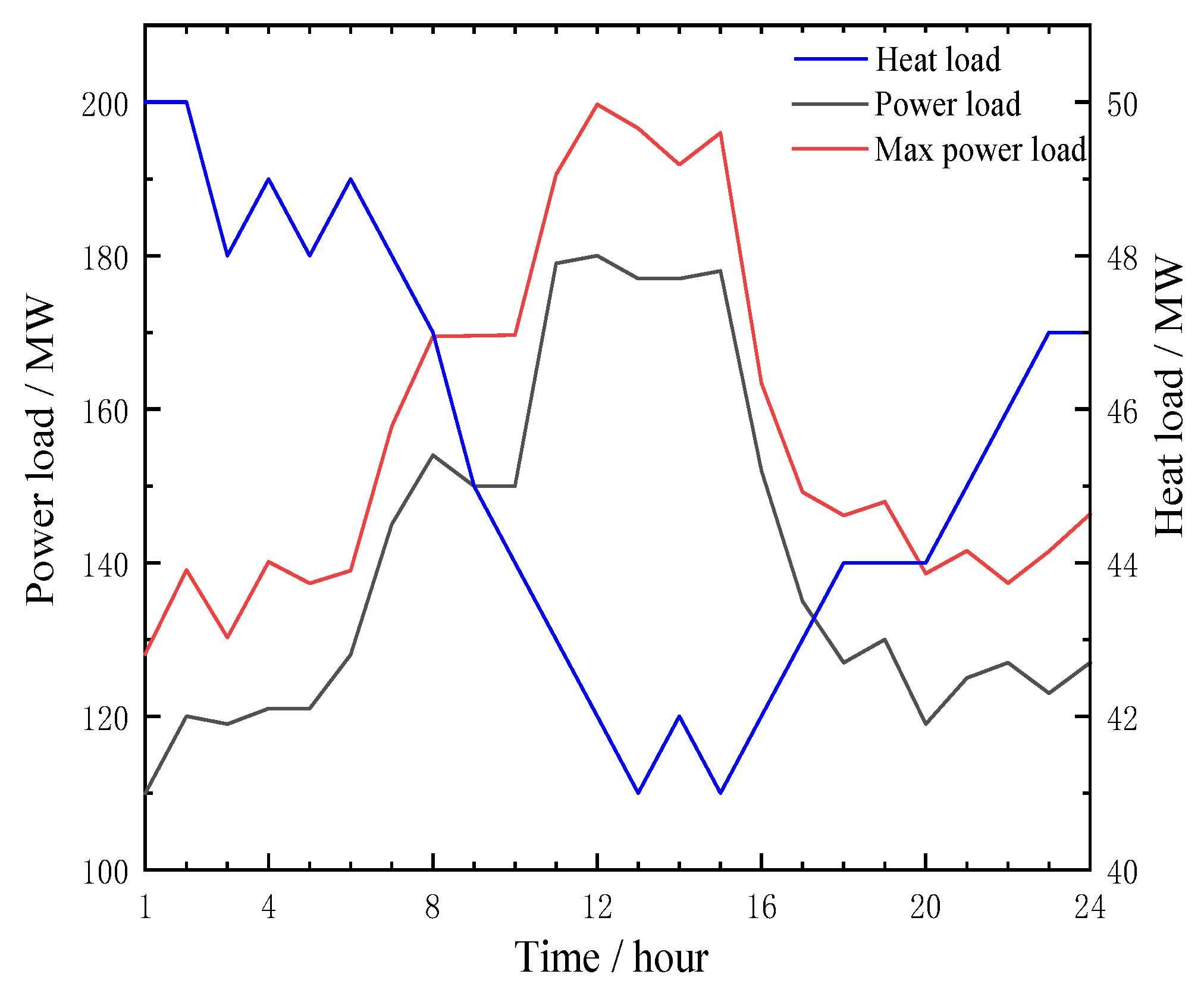
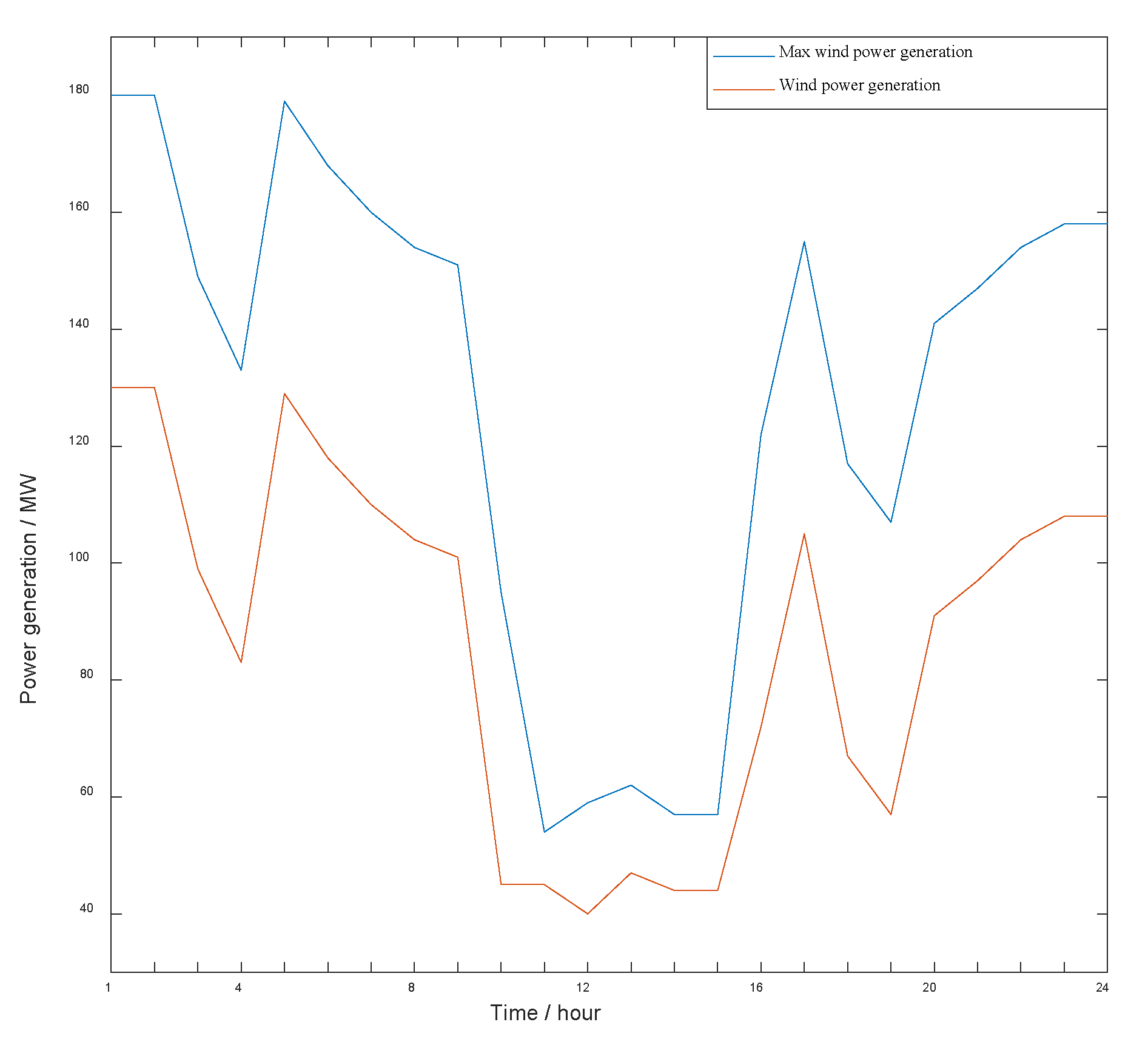
References
- Xia, S.; Bu, S.Q.; Luo, X.; Chan, K.W.; Lu, X. An autonomous real-time charging strategy for plug-in electric vehicles to regulate frequency of distribution system with fluctuating wind generation. IEEE Trans. Sustain. Energy 2018, 9, 511–524. [Google Scholar] [CrossRef]
- Salomón, M.; Savola, T.; Martin, A. Small-scale biomass CHP plants in Sweden and Finland. Renew. Sustain. Energy Rev. 2011, 15, 4451–4465. [Google Scholar] [CrossRef]
- Barco-Burgos, J.; Bruno, J.C.; Eicker, U.; Saldana-Robles, A.L.; Alcantar-Camarena, V. Review on the integration of high-temperature heat pumps in district heating and cooling networks. Energy 2022, 239, 122378. [Google Scholar] [CrossRef]
- Wang, H.; Lahdelma, R.; Wang, X.; Jiao, W.; Zhu, C.; Zou, P. Analysis of the location for peak heating in CHP based combined district heating systems. Appl. Therm. Eng. 2015, 87, 402–411. [Google Scholar] [CrossRef]
- Li, X.; Li, W.; Zhang, R.; Jiang, T.; Chen, H.; Li, G. Collaborative scheduling and flexibility assessment of integrated electricity and district heating systems utilizing thermal inertia of district heating network and aggregated buildings. Appl. Energy 2020, 258, 114021. [Google Scholar] [CrossRef]
- Dou, C.; Yue, D.; Li, X.; Xue, Y. MAS-based management and control strategies for integrated hybrid energy system. IEEE Trans. Ind. Inf. 2016, 12, 1332–1349. [Google Scholar] [CrossRef]
- Yue, D.; Han, Q.L.; Lam, J. Network-based robust H∞ control of systems with uncertainty. Automatica 2005, 41, 999–1007. [Google Scholar] [CrossRef]
- Weng, S.; Yue, D.; Dou, C.; Shi, J.; Huang, C. Distributed event-triggered cooperative control for frequency and voltage stability and power sharing in isolated inverter-based microgrid. IEEE Trans. Cybern. 2019, 49, 1427–1439. [Google Scholar] [CrossRef] [PubMed]
- Li, Y.; Yang, Z.; Li, G.; Zhao, D.; Tian, W. Optimal scheduling of an isolated microgrid with battery storage considering load and renewable generation uncertainties. IEEE Trans. Ind. Electron. 2019, 66, 1565–1575. [Google Scholar] [CrossRef] [Green Version]
- Wen, S.; Lan, H.; Fu, Q.; Yu, D.C.; Zhang, L. Economic allocation for energy storage system considering wind power distribution. IEEE Trans. Power Syst. 2015, 30, 644–652. [Google Scholar] [CrossRef]
- Barani, M.; Aghaei, J.; Akbari, M.A.; Niknam, T.; Farahmand, H.; Korpas, M. Optimal partitioning of smart distribution systems into supply-sufficient microgrids. IEEE Trans. Smart Grid 2019, 10, 2523–2533. [Google Scholar] [CrossRef]
- Nasrolahpour, E.; Kazempour, J.; Zareipour, H.; Rosehart, W.D. Impacts of ramping inflexibility of conventional generators on strategic operation of energy storage facilities. IEEE Trans. Smart Grid 2018, 9, 1334–1344. [Google Scholar] [CrossRef] [Green Version]
- Wang, L.F.; Singh, C.N. Stochastic combined heat and power dispatch based on multi objective particle swarm optimization. Int. J. Electr. Power Energy Syst. 2008, 30, 226–234. [Google Scholar] [CrossRef]
- Piperagkas, G.; Anastasiadis, A.; Hatziargyriou, N. Stochastic PSO-based heat and power dispatch under environmental constraints incorporating CHP and wind power units. Electr. Power Syst. Res. 2011, 81, 209–218. [Google Scholar] [CrossRef]
- Chen, X.; Kang, C.; O’Malley, M.; Qing, X.; Bai, J.; Liu, C.; Sun, R.; Wang, W.; Li, H. Increasing the flexibility of combined heat and power for wind power integration in China: Modeling and implications. IEEE Trans. Power Syst. 2015, 30, 1848–1857. [Google Scholar] [CrossRef]
- Chen, L.; Liu, N.; Li, C.; Wu, L.; Chen, Y. Multi-party stochastic energy scheduling for industrial integrated energy systems considering thermal delay and thermoelectric coupling. Appl. Energy 2021, 304, 117882. [Google Scholar] [CrossRef]
- Liao, T.; Xu, Q.; Dai, Y.; Cheng, C.; He, Q.; Ni, M. Radiative cooling-assisted thermoelectric refrigeration and power systems: Coupling properties and parametric optimization. Energy 2022, 242, 122546. [Google Scholar] [CrossRef]
- Li, Z.; Wu, W.; Wang, J.; Zhang, B.; Zheng, T. Transmission-constrained unit commitment considering combined electricity and district heating networks. IEEE Trans. Sustain. Energy 2016, 7, 480–492. [Google Scholar] [CrossRef]
- Huang, J.; Li, Z.; Wu, Q.H. Coordinated dispatch of electric power and district heating networks: A decentralized solution using optimality condition decomposition. Appl. Energy 2017, 206, 1508–1522. [Google Scholar] [CrossRef]
- Zhang, T.; Li, Z.; Wu, Q.H.; Zhou, X. Decentralized state estimation of combined heat and power systems using the asynchronous alternating direction method of multipliers. Appl. Energy 2019, 248, 600–613. [Google Scholar] [CrossRef]
- Wu, C.; Gu, W.; Jiang, P.; Li, Z.; Cai, H.; Li, B. Combined economic dispatch considering the time-delay of district heating network and multi-regional indoor temperature control. IEEE Trans. Sustain. Energy 2018, 9, 118–127. [Google Scholar] [CrossRef]
- Merlin, K.; Delaunay, D.; Soto, J.; Traonvouez, L. Heat transfer enhancement in latent heat thermal storage systems: Comparative study of different solutions and thermal contact investigation between the exchanger and the PCM. Appl. Energy 2016, 166, 107–116. [Google Scholar] [CrossRef]
- Arefifar, S.A.; Mohamed, Y.A.R.I. DG mix, reactive sources and energy storage units for optimizing microgrid reliability and supply security. IEEE Trans. Smart Grid 2014, 5, 1835–1844. [Google Scholar] [CrossRef]
- Kalkhambkar, V.; Kumar, R.; Bhakar, R. Joint optimal allocation methodology for renewable distributed generation and energy storage for economic benefits. IET Renew. Power Gener. 2016, 10, 1422–1429. [Google Scholar] [CrossRef]
- Li, Z.M.; Aminifar, F.; Alabdulwahab, A.; Al-Turki, Y. Networked microgrids for enhancing the power system resilience. Proc. IEEE 2017, 105, 1289–1310. [Google Scholar] [CrossRef]
- Turski, M.; Sekret, R. Buildings and a district heating network as thermal energy storages in the district heating system. Energy Build 2018, 179, 49–56. [Google Scholar] [CrossRef]
- Dainese, C.; Faè, M.; Gambarotta, A.; Morini, M.; Premoli, M.; Randazzo, G.; Rossi, M.; Rovati, M.; Saletti, C. Development and application of a predictive controller to a mini district heating network fed by a biomass boiler. Energy Procedia 2019, 159, 48–53. [Google Scholar] [CrossRef]
- Robert, E.; Kalehbasti, P.; Michael, D. A novel approach to district heating and cooling network design based on life cycle cost optimization. Energy 2020, 194, 116837. [Google Scholar]
- Schwarz, M.B.; Mabrouk, M.T.; Silva, C.S.; Haurant, P.; Lacarrière, B. Modified finite volumes method for the simulation of dynamic district heating networks. Energy 2019, 182, 954–964. [Google Scholar] [CrossRef]
- Liu, L.; Zhu, T.; Pan, Y. Multiple energy complementation based on distributed energy systems—Case study of Chongming county, China. Appl. Energy 2016, 192, 329–336. [Google Scholar] [CrossRef]
- Lahdelma, R.; Hakonen, H. An efficient linear programming algorithm for combined heat and power production. Eur. J. Oper. Res. 2003, 148, 141–151. [Google Scholar] [CrossRef]
- Lbrahim, R.A. Overview of mechanics of pipes conveying fluids—Part I: Fundamental studies. J. Press. Vessel Technol. 2010, 132, 034001. [Google Scholar] [CrossRef]
- Zhou, J.; Zhang, G.; Lin, Y.; Li, Y. Coupling of thermal mass and natural ventilation in buildings. Energy Build 2007, 40, 979–986. [Google Scholar] [CrossRef]
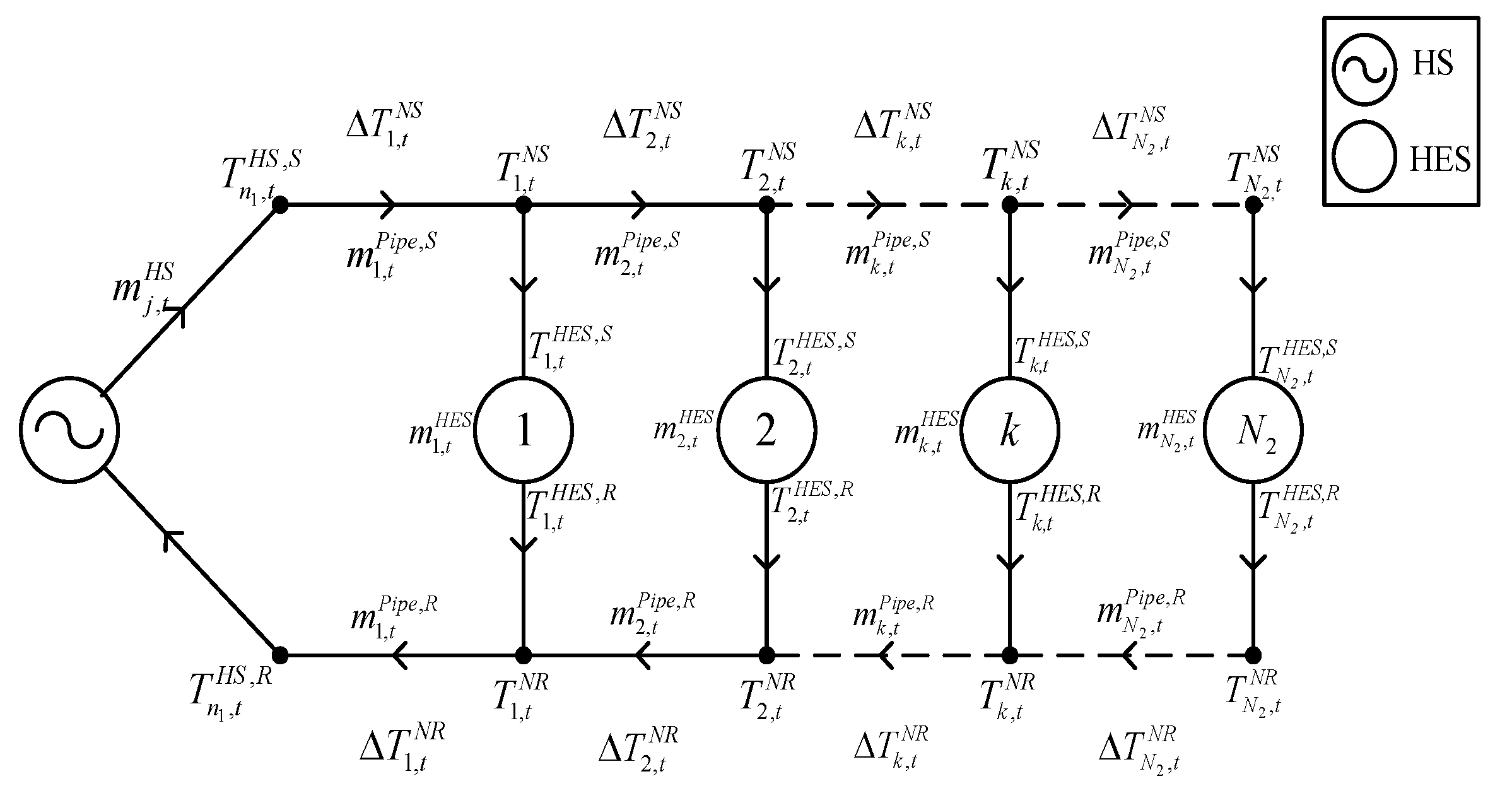



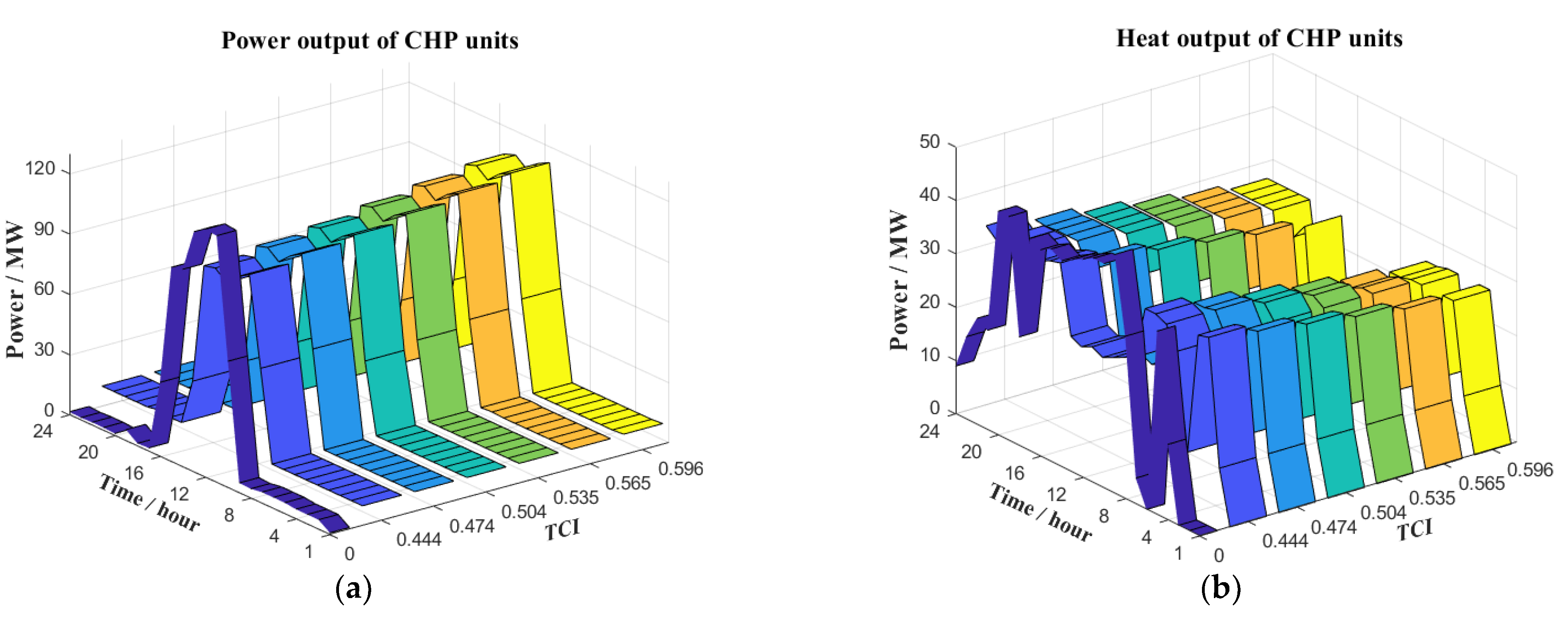
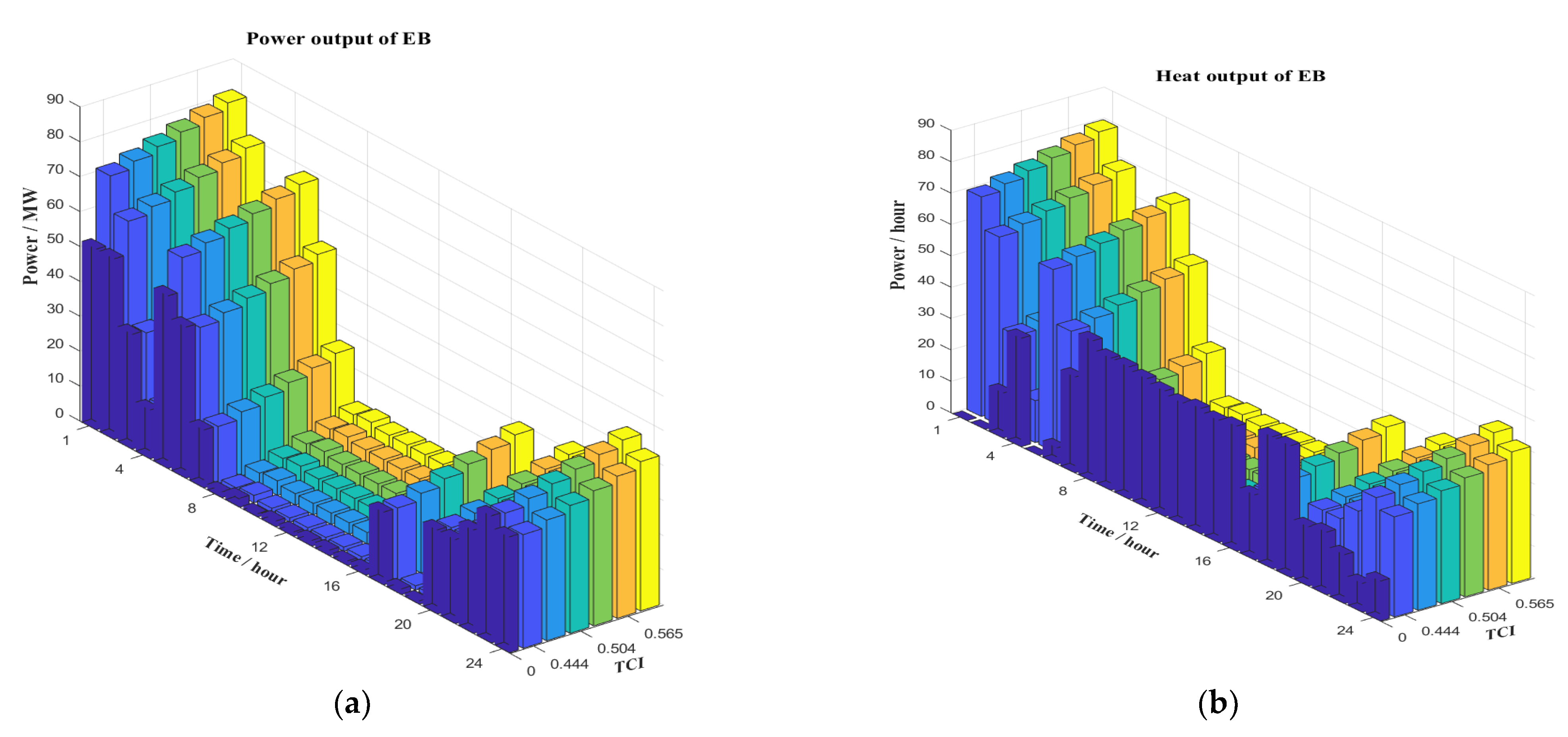
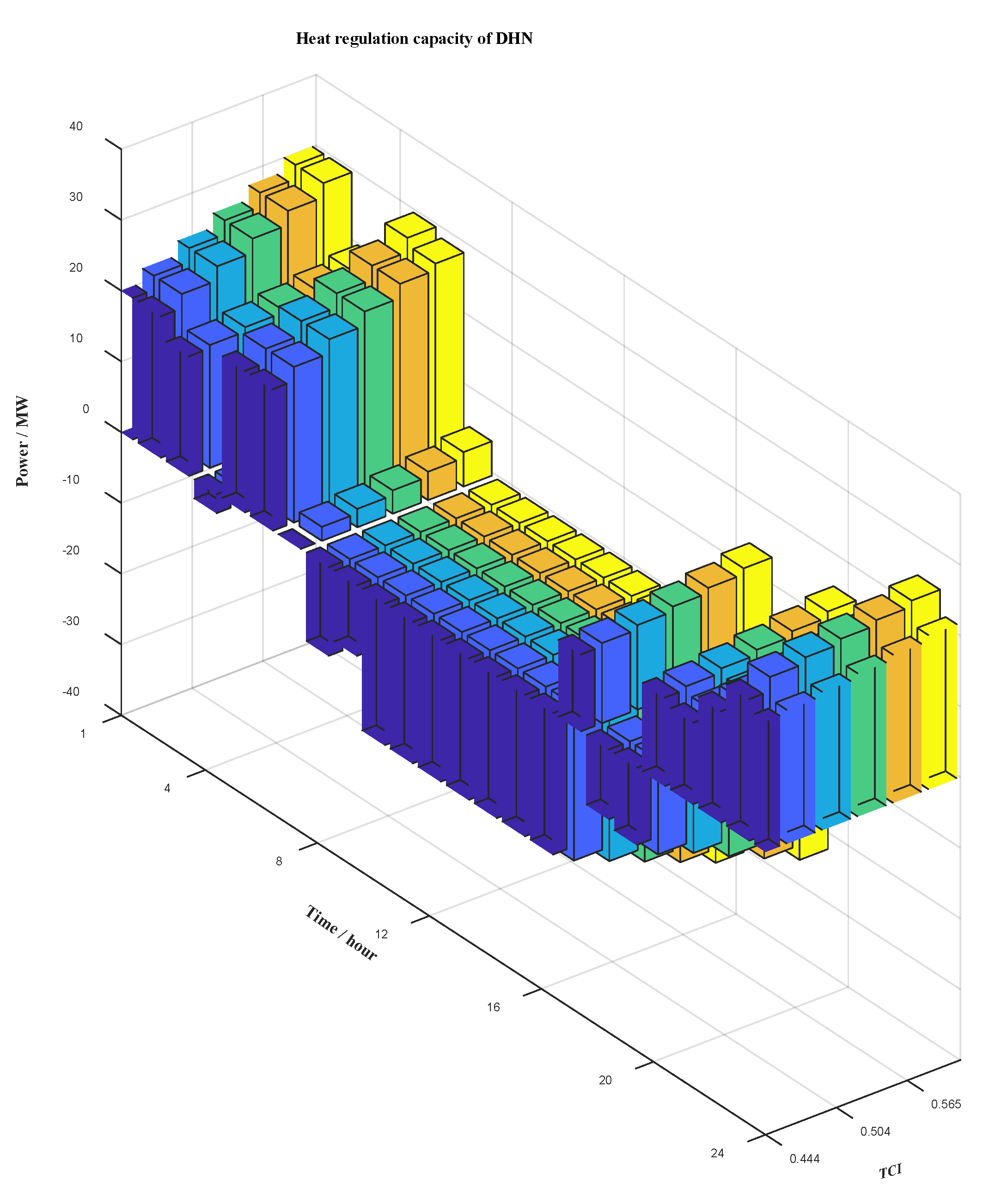
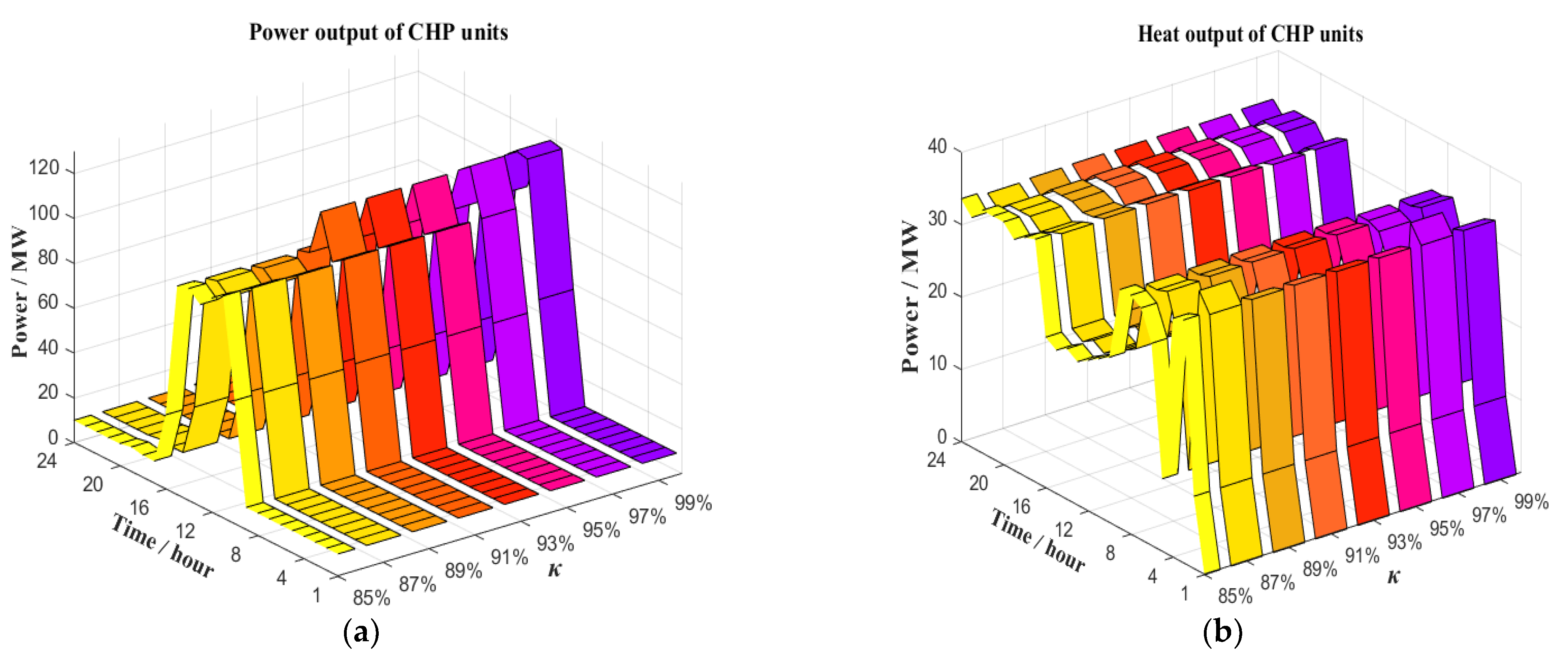
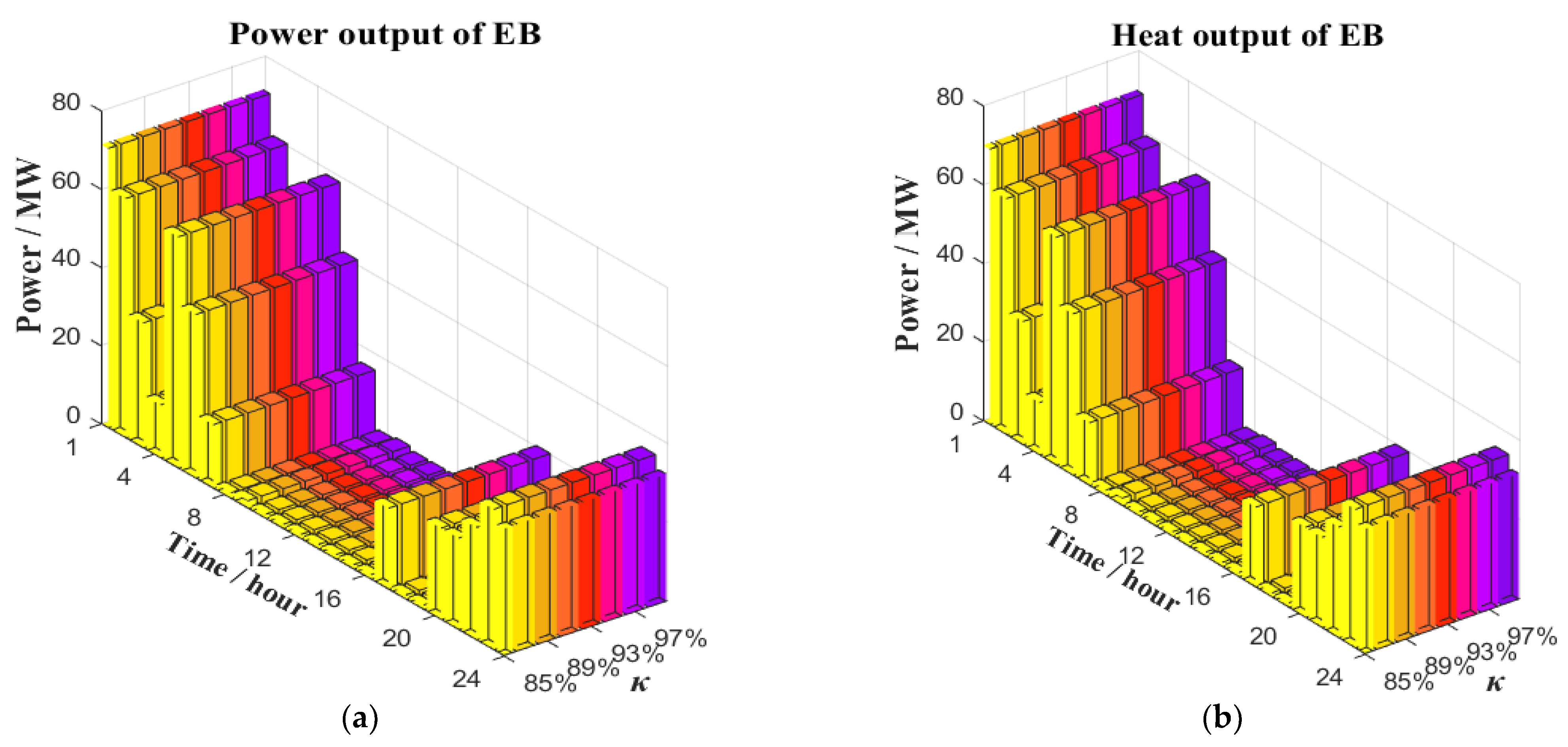
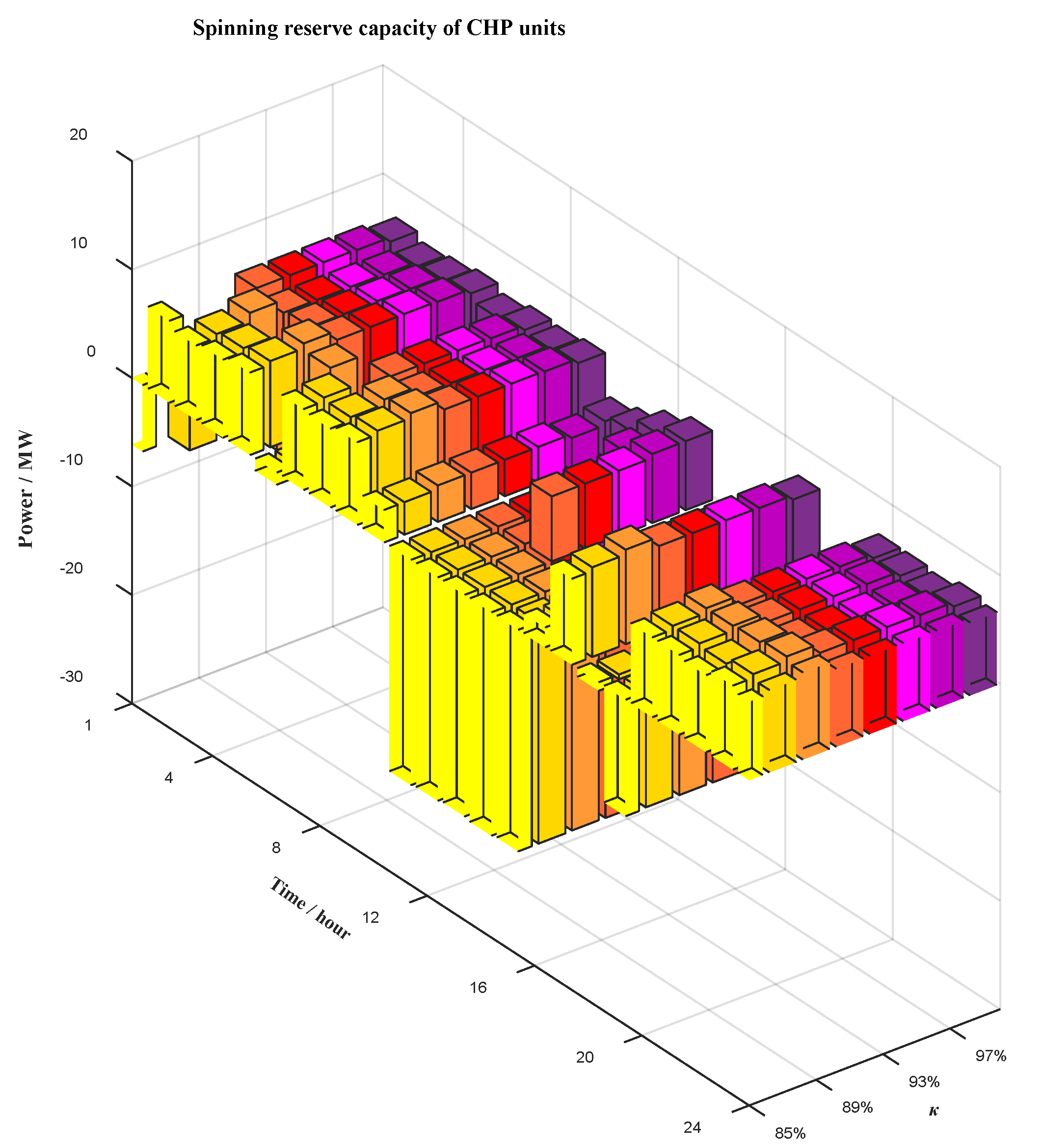
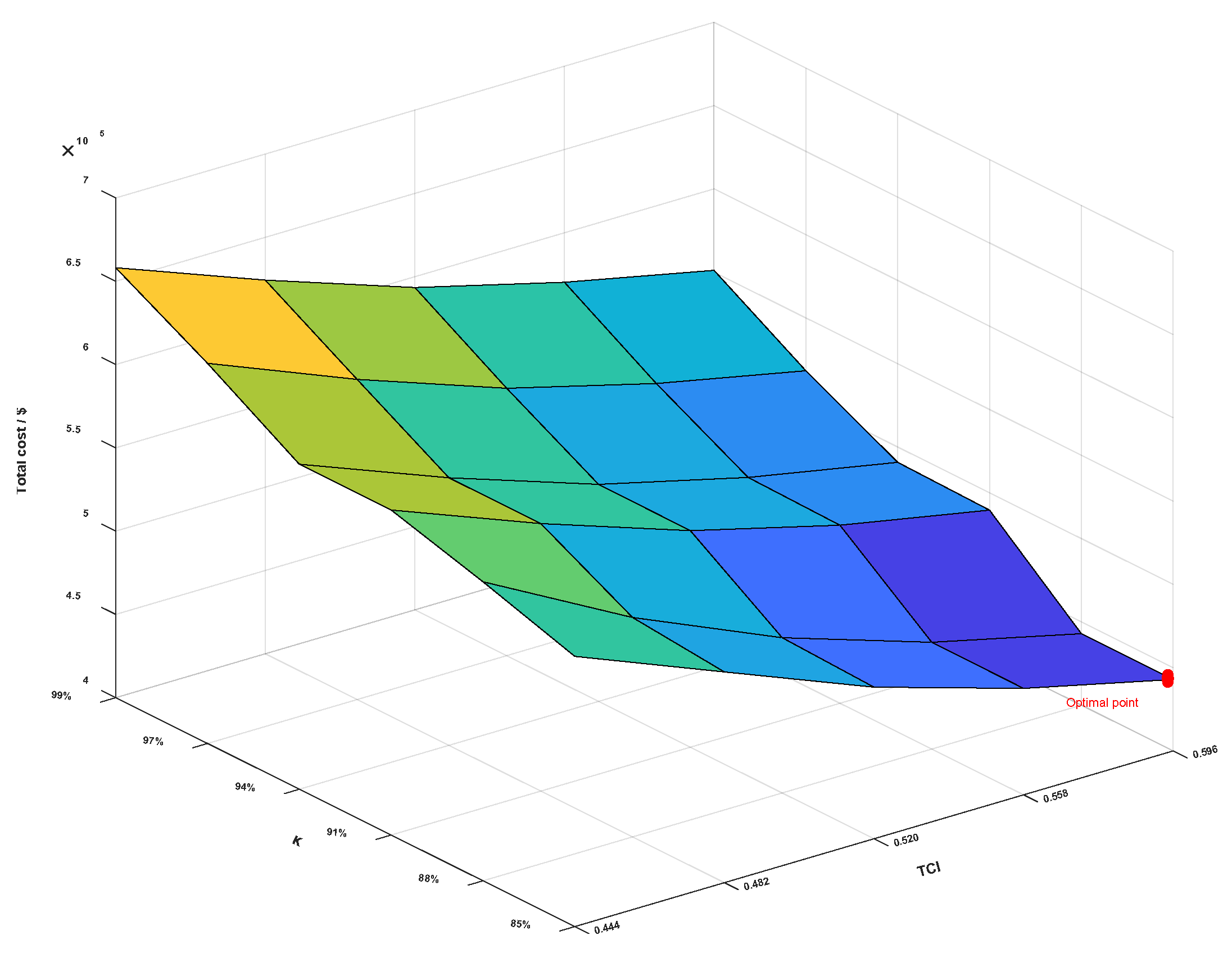
| 1: | Model building: |
| 2: | Uncertainty model of EPS; |
| 3: | CF-VT modelling of DHN. |
| 4: | Model conversion: |
| 5: | Transform chance probability into deterministic MILP constraints; |
| 6: | Set the mass flow rates, and calculate the temperature of HS, HES, pipelines. |
| 7: | Model solving: |
| 8: | Enter the parameters of TCES; |
| 9: | Set the constraints and objective function; |
| 10: | Solve the model using Yamip and Cplex solvers; |
| 11: | If find a solution? |
| 12: | Output the optimal scheduling scheme; |
| 13: | Else if |
| 14: | Update K and TCI and return to Step 9. |
| 15: | End |
| Test System | Electric Power System | District Heating Network | |||||||
|---|---|---|---|---|---|---|---|---|---|
| Bus | Line | CHP | WT | EES | EB | Node | Pipeline | HES | |
| Number | 2 | 2 | 2 | 1 | 1 | 1 | 6 | 10 | 3 |
Publisher’s Note: MDPI stays neutral with regard to jurisdictional claims in published maps and institutional affiliations. |
© 2022 by the authors. Licensee MDPI, Basel, Switzerland. This article is an open access article distributed under the terms and conditions of the Creative Commons Attribution (CC BY) license (https://creativecommons.org/licenses/by/4.0/).
Share and Cite
Li, G.; Tang, Q.; Hu, B.; Ma, M. Optimal Scheduling of Thermoelectric Coupling Energy System Considering Thermal Characteristics of DHN. Sustainability 2022, 14, 9764. https://doi.org/10.3390/su14159764
Li G, Tang Q, Hu B, Ma M. Optimal Scheduling of Thermoelectric Coupling Energy System Considering Thermal Characteristics of DHN. Sustainability. 2022; 14(15):9764. https://doi.org/10.3390/su14159764
Chicago/Turabian StyleLi, Guangdi, Qi Tang, Bo Hu, and Min Ma. 2022. "Optimal Scheduling of Thermoelectric Coupling Energy System Considering Thermal Characteristics of DHN" Sustainability 14, no. 15: 9764. https://doi.org/10.3390/su14159764






